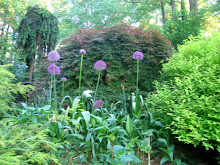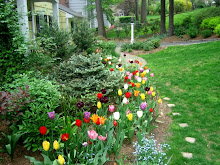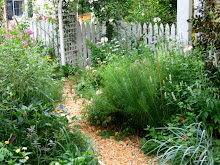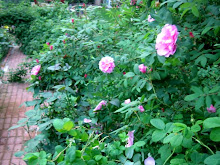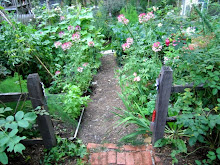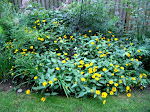I love attracting birds to the garden. While I have many plants during the growing season to attract birds--such as purple coneflower, black eyed susans, raspberries, serviceberry, rattlesnake master, and sunflowers-- there are fewer in the winter months. After all my crabapples and rose hips are gone, the birds are mainly attracted to the bird feeders and the bird baths during the winter months.  As you see in the picture, I have a multi-armed post with three feeders in the backyard. The one on the left looks like a little house with suet on the ends for the woodpeckers. If you look closely, there is a downy woodpecker on the back of the bird feeder in the picture. In the center of the house, there is a covered space that I use for shelled peanuts (a favorite of woodpeckers, nuthatches, and blue jays) and a seed blend for cardinals and other song birds. In the center (back), is a bird feeder for small backyard birds. One time instead of putting my regular mix in the feeder, I filled it with shelled sunflower seeds. The goldfinches love the sunflower hearts and are no longer attracted to the nyjer seeds which are recommended for them. On the right, is an all-purpose feeder for small birds. In the picture, there is a tufted titmouse on the birdfeeder. It is also a favorite of the house finches who are sitting on the branches of the Ceris 'Forest Pansy' behind and to the right.
As you see in the picture, I have a multi-armed post with three feeders in the backyard. The one on the left looks like a little house with suet on the ends for the woodpeckers. If you look closely, there is a downy woodpecker on the back of the bird feeder in the picture. In the center of the house, there is a covered space that I use for shelled peanuts (a favorite of woodpeckers, nuthatches, and blue jays) and a seed blend for cardinals and other song birds. In the center (back), is a bird feeder for small backyard birds. One time instead of putting my regular mix in the feeder, I filled it with shelled sunflower seeds. The goldfinches love the sunflower hearts and are no longer attracted to the nyjer seeds which are recommended for them. On the right, is an all-purpose feeder for small birds. In the picture, there is a tufted titmouse on the birdfeeder. It is also a favorite of the house finches who are sitting on the branches of the Ceris 'Forest Pansy' behind and to the right.
Welcome to Heirloom Gardener
Sunday, February 12, 2006
Birds in the Garden
Posted by
Julia Erickson
at
10:47 PM
0
comments
![]()
![]()
Labels: Wildlife in the Garden, Winter Garden
Snow in the Garden
 The warm weather over the past eight weeks was too good to be true. It has snowed over twelve inches since yesterday, and more snow is expected throughout the day and night. I ventured out to take some pictures of the garden.
The warm weather over the past eight weeks was too good to be true. It has snowed over twelve inches since yesterday, and more snow is expected throughout the day and night. I ventured out to take some pictures of the garden.
Descriptions of the pictures are enumerated from the top:
1. Butterfly Bush decorated with Christmas ornaments in the front garden next to the lamp post.
2. A grouping of spirea next to the front staircase. It is difficult to see with the snow, but behind the spirea are Rosa glauca and miscanthus 'Adagio.' Further back is Wiegela florida to the left and a lace bark pine in the center.
3. Lacecap hydrangea in the front garden. To the left of the hydrangea is the rose Frau Dargmar Harstrup.
4. The arbor over the entrance to the side garden is covered with the rose Dortmund. In the forefront of the picture are caryopteris. For winter interest, I hung a string of decorative apples on the fence.


Posted by
Julia Erickson
at
11:32 AM
0
comments
![]()
![]()
Labels: Front Border, Winter Garden
Saturday, February 11, 2006
Forced Branches and Bulbs: Forsythia, Hyacinth, Tulips, Muscari, and Crocus
 In February, I am always overwhelmed with winter and overwrought by the desire to garden again. This is when forcing branches and bulbs comes to the rescue. Forcing forsythia is easily done. All you need to do is cut several branches showing lots of flower buds, put them in a vase with water, place the vase in a sunny indoor location, and wait about 7 to 14 days for flowers to open. The flowers last for a good time and, if the water is frequently changed so it remains clean, leaves will follow the flowers.
In February, I am always overwhelmed with winter and overwrought by the desire to garden again. This is when forcing branches and bulbs comes to the rescue. Forcing forsythia is easily done. All you need to do is cut several branches showing lots of flower buds, put them in a vase with water, place the vase in a sunny indoor location, and wait about 7 to 14 days for flowers to open. The flowers last for a good time and, if the water is frequently changed so it remains clean, leaves will follow the flowers. The hardest step in forcing bulbs is planning ahead by buying and preparing the bulbs. Last October, I tucked away several extra bags of hyacinth, tulips, daffodils, muscari, and crocus for forcing. I have found that bulbs will force by chilling them in the refrigerator away from fruit for a minimum of ten weeks. After which they can be potted up inside as I need them. I also force bulbs by planting them in pots in the fall and, then, storing these pots in the garage for at least ten weeks. After the chill time, I bring the pots inside, water them, and they will grow and bloom in a matter of weeks.
The hardest step in forcing bulbs is planning ahead by buying and preparing the bulbs. Last October, I tucked away several extra bags of hyacinth, tulips, daffodils, muscari, and crocus for forcing. I have found that bulbs will force by chilling them in the refrigerator away from fruit for a minimum of ten weeks. After which they can be potted up inside as I need them. I also force bulbs by planting them in pots in the fall and, then, storing these pots in the garage for at least ten weeks. After the chill time, I bring the pots inside, water them, and they will grow and bloom in a matter of weeks. Usually, after the middle of January I will bring in a pot or pot up one each week. This combined with forsythia branches, snowdrops, and amaryllis will keep my home full of flowers until the first crocus appears.
Usually, after the middle of January I will bring in a pot or pot up one each week. This combined with forsythia branches, snowdrops, and amaryllis will keep my home full of flowers until the first crocus appears.
Posted by
Julia Erickson
at
10:36 PM
1 comments
![]()
![]()
Labels: Bulbs and Tubers, Cut and Forced Flowers
Gardening with Children: A Child's Garden by Molly Dannenmaier
I hope that by teaching children to love nature that as adults they will save and maintain native and heirloom plants. With that in mind, I am always looking for ideas and information to help kids fall in love with the garden. A Child's Garden by Molly Dannenmaier is the best book I've read on creating a garden for both children and parents in an average backyard:
A Child's Garden: 60 Ideas to Make Any Garden Come Alive for Children
The book offers information on how children play, which garden elements provide essential sparks for imaginative play, and how to integrate this into a residential garden. Photographs support the text by giving concrete examples of how to affect these ideas.
This coming spring I'm planning to incorporate several of these ideas into my own garden. Here are four of my upcoming projects:
- create a space for kids to dig besides the vegetable garden
- build a bin to gather natural materials such as seed pods, sticks, pine cones, and leaves as material for creating
- make simple topiaries with wire frames with the kids
- plant a living hiding spot with either a weeping mulberry, ornamental grasses, or a tepee made with grape or bean vines
Other good books I've read on kids' gardens are Roots, Shoots, Buckets & Boots and Great Gardens for Kids.
Related post: Ten Tips for Planning a Children's Garden
Posted by
Julia Erickson
at
9:47 PM
2
comments
![]()
![]()
Labels: Books and Movies, Gardening with Children
Saturday, February 04, 2006
Madame Isaac Pereire
 Madame Isaac Pereire blooms in spring and autumn. It has very large blossoms and is quite fragrant. I purchased it last year and it arrived approximately one foot in height. By the end of the season it was three feet tall. Although some say that the foliage is susceptible to black spot, I did not find that to be the case. Madame Isaac Pereire is available at http://www.weareroses.com/.
Madame Isaac Pereire blooms in spring and autumn. It has very large blossoms and is quite fragrant. I purchased it last year and it arrived approximately one foot in height. By the end of the season it was three feet tall. Although some say that the foliage is susceptible to black spot, I did not find that to be the case. Madame Isaac Pereire is available at http://www.weareroses.com/.
Posted by
Julia Erickson
at
11:45 PM
0
comments
![]()
![]()
Labels: Roses, Summer Garden
Friday, February 03, 2006
Elwes Snowdrop
 Unseasonably warm weather has my Elwes snowdrops blooming in the garden already--one month ahead of last year's blooms. The Elwes snowdrop, otherwise known as giant snowdrop, is native to Greece and dates back to the late 1800s. It is larger than the common snowdrop and blooms earlier, but has the same wonderful fragrance reminiscent of lilac.
Unseasonably warm weather has my Elwes snowdrops blooming in the garden already--one month ahead of last year's blooms. The Elwes snowdrop, otherwise known as giant snowdrop, is native to Greece and dates back to the late 1800s. It is larger than the common snowdrop and blooms earlier, but has the same wonderful fragrance reminiscent of lilac.
I love snowdrops. They are the first bulbs to bloom, oftentimes pushing through the snow. Not only do they offer the promise of spring, but also make wonderful cut flowers. The three petal flowers open to look like helicopters and reveal little white hoods with green markings and yellow stamen. I love to put a vase of these on a cake pedestal so I can look up at the flowers from my library table.
Plant snowdrops in the fall in groups of at least ten. Snowdrops can easily be tucked under shrubs, at the foot of deciduous trees, around evergreens and in between perennials. The key is to plant a lot of them: think 100s. My favorite place to buy bulbs in large quantities is Van Engelen Inc. They offer fall bulbs wholesale by catalog and on the web at http://www.vanengelen.com/. A hundred bulbs will cost less than $30. Snowdrops will also increase and in a few years you will have nice clumps of them.
Posted by
Julia Erickson
at
11:03 PM
0
comments
![]()
![]()
Labels: Bulbs and Tubers, Spring Garden
Thursday, February 02, 2006
Feverfew
 I was looking at pictures of my mixed border. The white daisy-like flowers in the lower right hand corner are feverfew. I decided to compost my feverfew at the end of last year because it re-seeds everywhere and the flowers have a most unpleasant fragrance. Forgetting this, I once mistakenly brought them into the house as cut flowers.
I was looking at pictures of my mixed border. The white daisy-like flowers in the lower right hand corner are feverfew. I decided to compost my feverfew at the end of last year because it re-seeds everywhere and the flowers have a most unpleasant fragrance. Forgetting this, I once mistakenly brought them into the house as cut flowers.
Posted by
Julia Erickson
at
11:55 PM
0
comments
![]()
![]()
Search Heirloom Gardener
Labels
- About Blogging
- Annuals/Biennials and Perennials
- Autumn Garden
- Books and Movies
- Botanical Gardens
- Bulbs and Tubers
- Children's Garden
- Chrysanthemum
- Clematis
- Container Gardening
- Crocus tommasiniasus roseus
- Cut and Forced Flowers
- Cutting and Rose Gardens
- Dahlias
- Deep Thoughts About Gardening
- Egg Garden
- Fences Arbors Walls and Paths
- Floral arrangements
- Front Border
- Fun Stories About Gardening
- Garden Bloggers' Bloom Day
- Garden Bloggers' Design Workshop
- Garden Planning
- Gardening Blogs
- Gardening Tools and Structures
- Gardening with Children
- Goldberry Hill
- Heirloom and Organic Food
- Hibiscus
- Holidays
- Hydrangeas
- Japanese Beautyberry
- Lilies
- Mixed Borders
- New Jersey / Local Interest
- Nurseries
- Online Gardening Resources
- Peonies
- Pest Control
- Picture This Photo Contest
- Piet Oudolf
- Poppies
- Propagation and Seeds
- Pruning and Maintenance
- Roses
- Seed Heads
- Self Seeders
- Shrubs
- Spring Garden
- Summer Garden
- Trees
- Wildlife in the Garden
- Winter Garden
- Zinia










